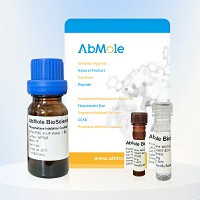
Polyethylenimine branched is a surfactant and a non-viral gene delivery vector rich in positively charged amine groups, which can be used in studies related to drug delivery (especially oligonucleotide delivery), and is also one of the most commonly used reagents in small- to large-scale transfection.
| Molecular Weight | 800 |
| CAS Number | 25987-06-8 |
| Storage | RT |
| Species | Mouse | Rat | Rabbit | Guinea pig | Hamster | Dog |
| Weight (kg) | 0.02 | 0.15 | 1.8 | 0.4 | 0.08 | 10 |
| Body Surface Area (m2) | 0.007 | 0.025 | 0.15 | 0.05 | 0.02 | 0.5 |
| Km factor | 3 | 6 | 12 | 8 | 5 | 20 |
| Animal A (mg/kg) = Animal B (mg/kg) multiplied by | Animal B Km |
| Animal A Km |
For example, to modify the dose of Compound A used for a mouse (20 mg/kg) to a dose based on the BSA for a rat, multiply 20 mg/kg by the Km factor for a mouse and then divide by the Km factor for a rat. This calculation results in a rat equivalent dose for Compound A of 10 mg/kg.
[5] Paola Vicennati et al. Curr Med Chem. Polyethylenimine in medicinal chemistry
| Related Cell Transfection Products |
|---|
| Chitosan (MW 150000)
Chitosan (MW 150000) is a polycationic linear polysaccharide derived from chitin with a molecular weight of 150000.Chitosan is non-toxic, hypoallergenic, biocompatible, biodegradable, and possesses anti-tumor, anti-bacterial, anti-fungal, and anti-oxidant activities.Chitosan can be used in studies related to drug delivery and cell transfection. |
| Chitosan (MW 30000)
Chitosan (MW 30000) is a polycationic linear polysaccharide derived from chitin with a molecular weight of 30,000.Chitosan is non-toxic, hypoallergenic, biocompatible, biodegradable, and possesses anti-tumor, anti-bacterial, anti-fungal, and antioxidant activities.Chitosan can be used in studies related to drug delivery and cell transfection. |
| DMTAP
DMTAP is a cationic lipid that can be used for delivery of DNA, RNAi and drugs. |
| Polyethylenimine, Linear (MW 25000)
Polyethylenimine Linear (PEI) solution consists of a cationic polymer transfection reagent with a molecular weight of 25,000, which forms a complex with nucleic acids and allows the complex to enter mammalian cells. In addition, Polyethylenimine Linear is one of the most commonly used reagents in small to large scale transfection. |
| Polyethylenimine, Linear (MW 25000, liquid)
Polyethylenimine Linear (PEI) solution consists of a cationic polymer transfection reagent with a molecular weight of 25,000, which forms a complex with nucleic acids and allows the complex to enter mammalian cells. |


Products are for research use only. Not for human use. We do not sell to patients.
© Copyright 2010-2023 AbMole BioScience. All Rights Reserved.
